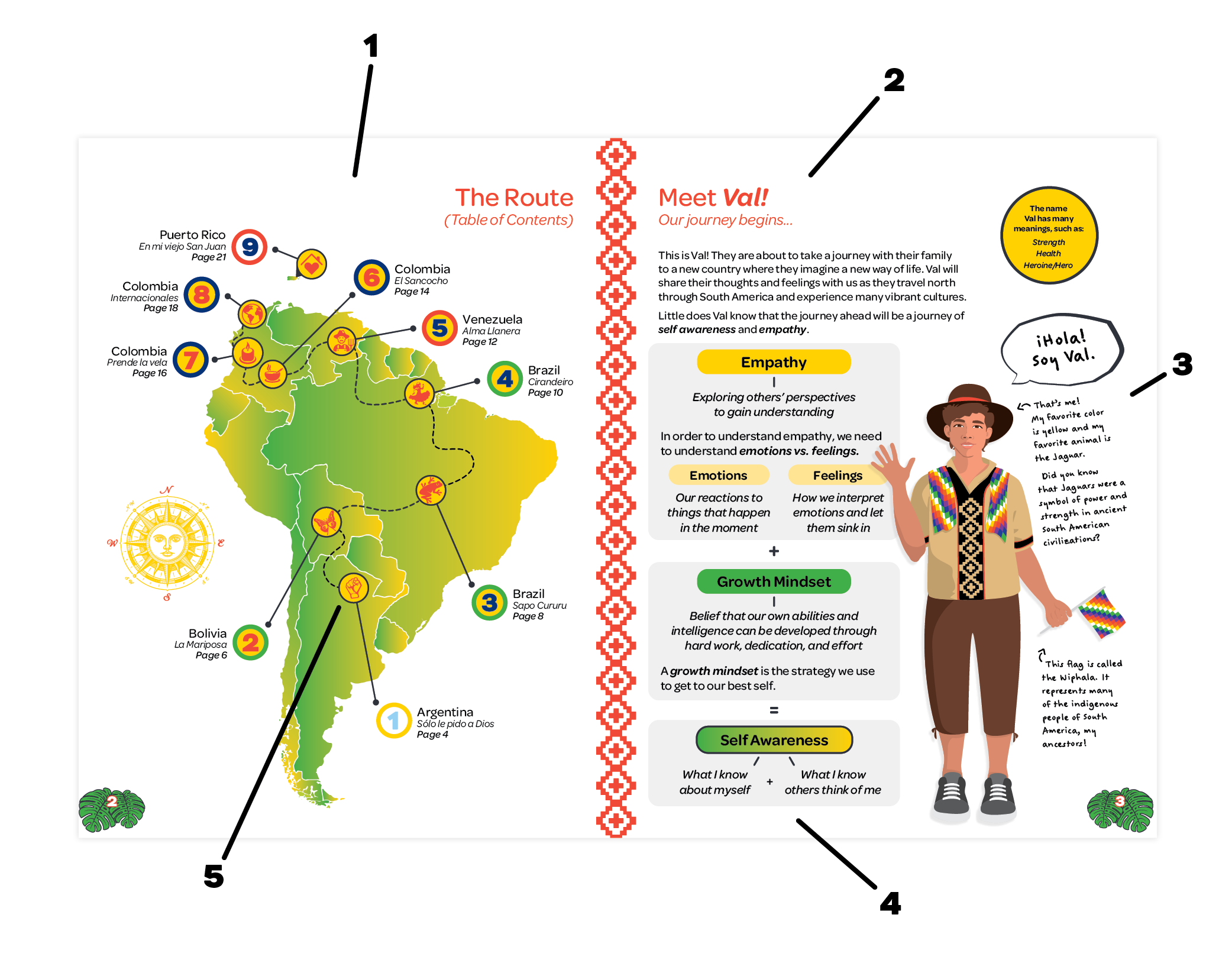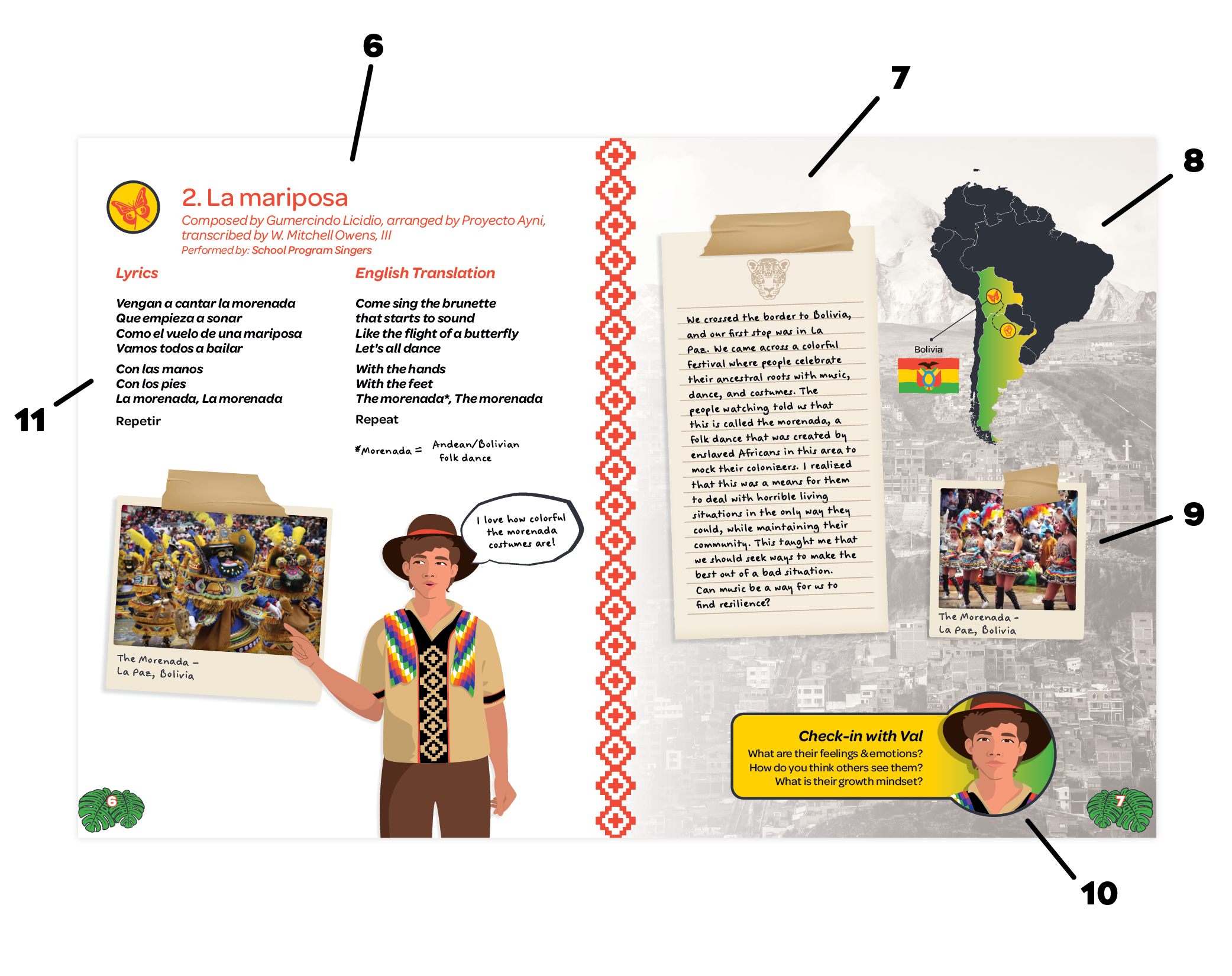
A staple of our world-class music education programs are our learning packets, provided to singers at every level of our programs (School, Neighborhood Choir, Dimension and Voice of Chicago). These packets are developed by our best-in-class music educators for three of our pillar events annually: Canto Latino, Black History Concert Series and Paint the Town Red. They serve as tools to help our singers learn both the songs themselves as well as their cultural contexts, heritage, and importance to the event overall.
For the first time, we’re sharing an annotated sample of our packet for this year’s Canto Latino event so you can see how our conductors use these packets as learning tools in the classroom. Our singers don’t just learn music from many genres, cultures and languages, but understand how the music is created and engage in conversation about the historical and social context of the songs.
Thanks to our Canto Latino curators and curriculum developers, conductors Dewey Bolz, Magdalena Delgado, Veronica Román-Meyer, Heather Stewart and Amanda Wolff for contributing their knowledge to this piece, in addition to Multimedia Designer Kell Fahey.
See the songs in action at Canto Latino: Alma del Sur, on Saturday, October 5 from 3-6pm in Senka Park.

1. The Map
This year, Canto Latino is celebrating the cultures and music of South America, including Argentina, Brazil, Venezuela, Colombia and more. We included the map because it allows students to track Val’s journey geographically, and it teaches them about the location of these different countries that we are musically exploring.
2. Meet Val
Storytelling is a powerful teaching tool and way to convey knowledge and build a sense of empathy and belonging. We wanted to tell the story of many migrants that are recently traveling north from South America. We hear about it in the news, mostly with a negative connotation, and our students may encounter these newcomers in their communities and at schools, but what they don’t hear is about these peoples’ stories. In Val, we wanted to create a young character who would attract curiosity from our young singers, with the purpose of exploring empathy and self awareness.
3. Val’s Design
When designing the character who would guide this story, we had to identify what was most important about Val. Val is a non-binary teen from Argentina with indigenous ancestry. The team expressed that they wanted Val to be modern, but with clear nods to their indigenous roots. Val’s design is inspired by photos of different people from the area, their clothing and their traditions. The clothing Val wears is strongly influenced by the Kolla tribe. The scarf and Wiphala flag are representative of many different native peoples of South America. Val’s shirt pattern is something our designer took directly from a traditional Argentinian poncho, and they tried to make the shirt feel like something a teen would wear today. The hat is a style commonly worn in the area as well.
4. What is Social-emotional learning?
Social-emotional learning is not a lens; it is the act of learning itself. The goal of our comprehensive curricula this year is to help our singers build self-awareness skills. The aim of our pedagogy with Canto Latino: Alma la sur is to lay the groundwork for our singers to build self-awareness–a fundamental catalyst for learning and growth–which we will continue to develop throughout our other pillar events throughout the year, namely our Black History Concert Series and Paint the Town Red. Self-awareness is two-pronged; it requires an awareness of self (an intrapersonal skill) as well as an awareness of the perception of others about ourselves in a social context (an interpersonal skill). Developing a growth mindset improves our sense of self as we discover our identity/ies. Empathy allows us to understand ourselves and others when we unpack emotions and feelings. By identifying emotions vs. feelings in ourselves and others, we come to appreciate other perspectives and mental processes and gain a better understanding of our place in the world around us.
5. Map icons
Each icon is representative of the song it accompanies. The idea was that each stop on Val’s journey is a “stepping stone.” Iconography is a powerful tool to help kids recall information and make connections. Using the icons on the map helps to reinforce the connection between the songs and the regions from which they originate in a fun and accessible way.

6. Title/Program Info
We include the name of the song and the different musicians who contributed to it (composers, lyricists, arrangers, translators and others) for our students. While connecting with our Bolivian communities in preparation for Canto Latino, we were inspired by a dance troupe named Renacer Boliviano who share their Bolivian culture and identity through traditional Bolivian dance. We decided to collaborate with Renacer Boliviano and chose a song titled La mariposa that asks people to come and dance the morenada. La mariposa not only represents a Bolivian dance, but also “the butterfly” represents those who travel far distances, which is a direct connection to our character Val’s journey north.
7. Storytelling
These are Val’s journal entries. Each time Val and their family arrive in a different country on their journey, Val narrates the interactions through these journal entries. This allows for a connecting thread throughout the packet and it also has valued information about the culture and music that Val and their family are exploring.
8. Map
We include the country each song came from to bring awareness and knowledge to the origin of each song. Because each song is from a different culture, we want our singers to know where the country is located and how it represents a larger Latin American culture according to where it is geographically located.
9. Imagery
It is important for our singers to have a visual representation of what we sing about, especially if it is related to movement. The singers are more likely to understand it if they see an image. This also gives them more details about the culture because the images provide them with other information about the culture, for example, costumes and colors.
10. Check-in with Val
Self-reflection is an important practice that allows us to become more self-aware. These “Check-ins with Val” are quick, consistent check-points that allow us to practice defining emotions vs. feelings and practice empathy by putting ourselves in Val’s shoes.
11. Lyrics and translations
Uniting Voices Chicago teaches songs in many languages as part of their curriculum. We include the English translations because this will help them understand the meaning of the songs in the English language. Expression is one of our three core values, so empowering our singers with translations allows them to understand the song better, and express its meaning through their performance and movement.